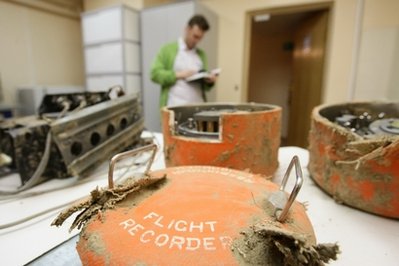Global General
Details revealed in Kaczynski crash probe
(Agencies)
Updated: 2010-05-20 06:31
 |
Large Medium Small |
MOSCOW – At least two passengers visited the cockpit of Polish President Lech Kaczynski's plane before it crashed last month, and others may have chatted on cell phones, possibly affecting navigation as the crew battled heavy fog over challenging terrain.
 Flight recorders of the Tu-154 that crashed on April 10 killing Poland's president and 95 others are on display at Russian Interstate Aviation Committee in Moscow Wednesday, May 19, 2010. [Agencies] |
Those were among the details revealed Wednesday by Russian and Polish officials investigating the April 10 crash that killed Kaczynski, his wife and 94 others outside the western Russian city of Smolensk. The preliminary report drew no conclusions about what caused the crash.
| ||||
Alexei Morozov, head of the technical commission of Russia's Interstate Aviation Committee, told reporters that among the questions that need further investigation is whether the rolling terrain around the Smolensk military airport distorted instrument readings.
The plane went down in a ravine 15 meters (50 feet) below the level of the runway, just a kilometer away.
"The presence of this ravine can have a natural influence on the readings of the radio altimeter," Morozov said. "This is one of the subjects the technical commission is working on."
He also said the commission was probing whether the use of cell phones aboard the Tu-154 affected its navigation.
The most tantalizing detail was that two voices not belonging to crew members showed up on the cockpit flight recorders. Officials said it was not clear to whom one of the voices belonged, declined to identify the other person and didn't report what either person said.
The information could feed speculation in Poland that Kaczynski or someone in his entourage pressured the crew to land despite visibility that had shrunk to about 200 meters (660 feet).
Edmund Klich, Poland's envoy to the investigation, said only that "certain suggestions" were made by the passengers that he believed had no influence on the plane's fate, though he acknowledged he had not heard the recordings. The voices were heard no later than 16 minutes before the crash.
Poland's PAP agency said it learned from a source close to the investigation in Moscow that one of the two voices in the cockpit that did not belong to a crew member was that of the Air Force Commander, Gen. Andrzej Blasik.
Morozov said the Polish air force crew piloting the plane had been assembled only a few days before the flight and that they had not received regular training that could have helped them cope with unusual conditions.
About five seconds before the plane hit a tree in the ravine, the captain switched off the autopilot and started to bank around for a second landing attempt, Morozov said. An automated voice warned "pull up" about 18 seconds before the crash, and before that the crew twice heard the phrase "terrain ahead," Morozov said.
The pilot appeared to have ignored advice to land elsewhere. About 11 minutes before the crash the crew of a Russian plane informed the Polish crew that it had made two attempts to land before changing course for another airport. Seven minutes later the crew of a Polish Defense Ministry plane that had landed in Smolensk 90 minutes earlier informed the presidential plane that visibility had deteriorated.
The officials on Wednesday confirmed earlier reports that the Polish plane, though in service for more than 30 years, was in good condition and had undergone proper inspection. Proper radar facilities were in place at the Smolensk airport, which was inspected on April 5 and found to be fit to accept VIP flights.


